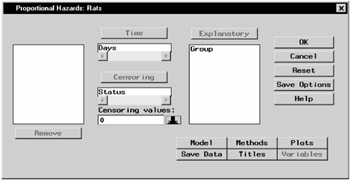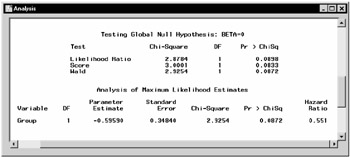Proportional Hazards
|
| < Day Day Up > |
|
The example in this section contains information on a different study that explores survival times of rats exposed to a carcinogen. Two groups of rats received different pretreatment regimes and were exposed to a carcinogen. Investigators recorded the survival times of the rats from exposure to death from vaginal cancer. Interest lies in whether the survival curves differ between the two groups. The data set Rats contains the variables Days, Status, and Group. The variable Days is the survival time in days. Status is the censoring variable and has the value 0 if the observation is censored and 1 if the observation is not censored. The Group variable indicates the pretreatment group, which takes the value 0 for the first treatment and 1 for the second treatment.
Open the Rats Data Set
The data are provided in the Analyst Sample Library. To open the Rats data set, follow these steps:
-
Select Tools → Sample Data...
-
Select Rats.
-
Click OK to create the sample data set in your Sasuser directory.
-
Select File → Open By SAS Name...
-
Select Sasuser from the list of Libraries.
-
Select Rats from the list of members.
-
Click OK to bring the Rats data set into the data table.
To request proportional hazards regression, follow these steps:
-
Select Statistics → Survival → Proportional Hazards...
-
Select Days as the time variable.
The values of Days are considered censored if the value of Status is 0; otherwise, they are considered event times.
-
Select Status as the censoring variable.
-
Specify 0 as the censoring value by directly typing 0 in the Censoring values: field or by clicking the down arrow under Censoring values: and selecting 0 from the list.
-
Select Group as the explanatory variable.

Figure 14.8: Proportional Hazards Dialog
Click OK in the Proportional Hazards main dialog to produce the results for the proportional hazards task.
Review the Results
The results are presented in the project tree under the Proportional Hazards folder. Double-click on the icon labeled Analysis to display the corresponding information in an independent window.
Figure 14.9 displays likelihood statistics and the analysis of parameter estimates. Since Group takes only two values, the null hypothesis for no difference between two groups is identical to the null hypothesis that the regression coefficient for Group is 0. All three tests in the "Testing Global Null Hypothesis: BETA=0" table suggest that the two pretreatment groups may not be the same. In this model, the hazards ratio (or risk ratio) for Group, defined as the exponentiation of the regression coefficient for Group, is the ratio of hazard functions between the two groups. The estimate is 0.551, implying that the hazard function for group 1 is smaller than the hazard function for group 0. In other words, rats in group 1 lived longer than those in group 0.

Figure 14.9: Proportional Hazards- Results
In this example, the comparison of two survival curves is put in the form of a proportional hazards model. This approach is essentially the same as the log-rank (Mantel-Haenszel) test. In fact, if there are no ties in the survival times, the likelihood score test in the Cox regression analysis is identical to the log-rank test. The advantage of the Cox regression approach is the ability to adjust for the other variables by including them in the model. For example, including a variable that contains the initial body weights of the rats could expand the present model.
|
| < Day Day Up > |
|
EAN: 2147483647
Pages: 116